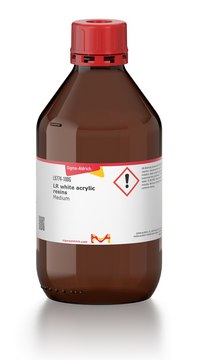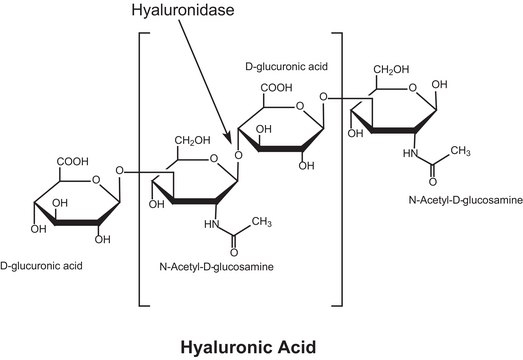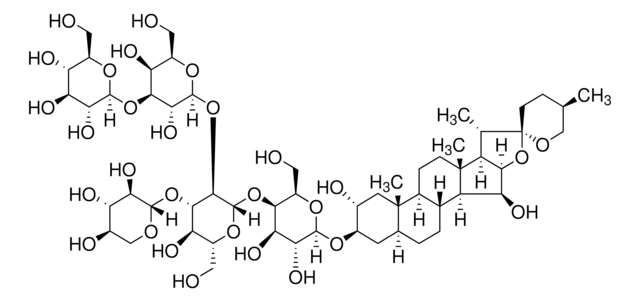Recommended Products
application(s)
hematology
histology
storage temp.
2-8°C
General description
Polymerization without accelerator at 60°C, with accelerator at room temperature.
The components can also be ordered separately under the product numbers indicated.
The components can also be ordered separately under the product numbers indicated.
Application
LR White Resin is a very low viscosity resin, non-toxic and suitable for various applications in both light and Electron Microscopy. A major advantage of LR White sections is that they show minimal non-specific staining. Sections of polymerized resin are hydrophilic, thus immunocytochemistry reagents easily penetrate into the section. Its low viscosity makes LR White an ideal tool for infiltrating plant tissues as well as decalcified bone and teeth.
Components
Composition:
62661 LR White resin, 1×500 ml
62660 LR White Accelerator, 1×10 ml
62663 LR White Catalyst, 1×10 g
62661 LR White resin, 1×500 ml
62660 LR White Accelerator, 1×10 ml
62663 LR White Catalyst, 1×10 g
Signal Word
Danger
Hazard Statements
Precautionary Statements
Hazard Classifications
Acute Tox. 3 Dermal - Acute Tox. 3 Inhalation - Acute Tox. 3 Oral - Aquatic Acute 1 - Aquatic Chronic 1 - Eye Irrit. 2 - Org. Perox. D - Repr. 1B - Skin Irrit. 2 - Skin Sens. 1 - STOT RE 2 Oral - STOT SE 3
Target Organs
Reproductive organs, Respiratory system
WGK
WGK 3
Regulatory Information
新产品
Certificates of Analysis (COA)
Search for Certificates of Analysis (COA) by entering the products Lot/Batch Number. Lot and Batch Numbers can be found on a product’s label following the words ‘Lot’ or ‘Batch’.
Already Own This Product?
Find documentation for the products that you have recently purchased in the Document Library.
Shuji Yamashita et al.
Journal of electron microscopy, 58(4), 267-279 (2009-04-01)
We have developed a new standardized method for the post-embedding immunoelectron microscopy using the same fixation, antigen retrieval and image contrasting procedures. Tissues were fixed with 4% formaldehyde containing 2.5 mM CaCl(2), 1.25 mM MgCl(2) in a 0.1 M 4-(2-hydroxyethyl)-piperazineethanesulfonic
Shuji Yamashita
Methods in molecular biology (Clifton, N.J.), 657, 237-248 (2010-07-06)
We describe a standardized method of fixation, antigen retrieval, and image contrasting for post-embedding immunoelectron microscopy. Tissues are fixed with formaldehyde solutions containing Ca(2+) and Mg(2+) ions at pH 7.4 and then at pH 8.5. After dehydration with dimethylformamide, the
Virawudh Soontornniyomkij et al.
Human pathology, 41(11), 1601-1608 (2010-08-07)
The occurrence and progression of cerebral β-amyloid angiopathy and β-amyloid plaques in sporadic Alzheimer's disease may be attributed to aging-related deficiencies in β-amyloid drainage along cerebral perivascular pathways. To elucidate high-definition characteristics of cerebral β-amyloid deposition, we performed immunogold silver
Margarita Sobol et al.
Histochemistry and cell biology, 135(1), 103-110 (2010-12-15)
The best available approach of biological sample preparation for transmission electron microscopy currently includes cryoimmobilization by high-pressure freezing (HPF) followed by freeze-substitution (FS). This method has been well established for interphase cells; however, a reliable and easy procedure is still
C J von Ruhland et al.
Journal of microscopy, 240(2), 130-134 (2010-10-16)
The utility of LR White sections as slot grid support films for the examination of thin resin-embedded tissue sections by transmission electron microscopy was investigated and compared with traditional formvar-carbon films. Throughout a variety of staining procedures, which involved the
Our team of scientists has experience in all areas of research including Life Science, Material Science, Chemical Synthesis, Chromatography, Analytical and many others.
Contact Technical Service








